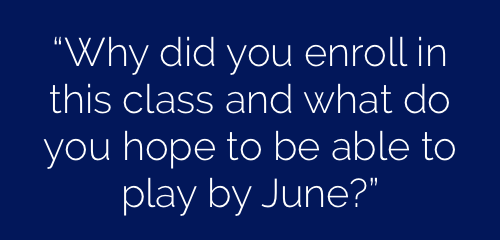This blog is written by Joe Sweet, a guitar teacher at Lane Technical College Preparatory High School in Chicago. Joe has created a ton of great guitar teacher resources here.
“Education is not the filling of a pail, but the lighting of a fire”
W.B. Yeats
When asked what my educational philosophy is, I always refer to this quote. My experience has been that our job works best when we get our students excited and engaged about music; then they will be only too happy to do the heavy lifting. Trying to “fill their pail” as it were, is an exhausting endeavor that wastes both parties’ time. When a student is excited about a subject they are suddenly unaware of the time and effort they are putting forth. It becomes a joy and a labor of love for both teacher and student.
How, then, do we light that fire? My personal experience with taking my first guitar lessons at the age of 9 was a miserable one. My teacher was clearly uninterested in being there and never asked me what I wanted to learn. As a consequence, I spent the next two years horribly unhappy and fighting what would later become my life’s passion. I was given songs that I either wasn’t interested in learning or had never heard of. The first question I ask my students at the beginning of the year is “Why did you enroll in this class and what do you hope to be able to play by June?” This essay is assigned the first day of class and helps me understand where my students are coming from and what they hope to learn.

By performing modern music that holds an interest for our students we have already won the toughest part of a teacher’s challenge: Motivation! I’m not suggesting that classical music has no interest in contemporary society but its catalog does have a limited appeal today. If we are to grab beginning musicians’ attention, it would be best to start first with what they know and then introduce them to other genres such as: Blues, Jazz, Latin and Classical music. This has been my experience.
As far as tablature versus standard musical notation, I choose both. I believe both have their place. I begin the year by teaching standard musical notation on the 1st string and then add another string to the mix approximately every 2 to 3 weeks. However, I do introduce my students to a “12 Bar Blues in E” using chords the first week and then I quickly transition them to a shuffle. (Often referred to as a Barrelhouse shuffle) This has always held an interest for my students of all ages. They have heard this sound in recordings such as “Sweet Home Chicago,” “Johnny B. Goode” and others. They get to experience sounding just like a song that they have actually heard before. From that success, they become engaged and are motivated to work harder and the snowball starts rolling downhill.
The music I give my students for the “12 Bar Blues in E” is denoted by tablature in lieu of the standard musical notation. If I were to wait until all my students could read the standard music notation for a blues shuffle, which is largely played on the lower strings of the guitar and would include up to three ledger lines below the staff, they wouldn’t start learning a 12 bar blues shuffle until sometime towards the end of the first semester. They have the physical capability to play it almost immediately after they learn how to hold a guitar properly. It is not a particularly challenging thing to play but I’ve found it to be very rewarding for new students. Why not get them started as soon as possible with tablature for the “12 Bar Blues?”
Let’s light that fire as early as we can!
Joe has created a ton of great guitar teacher resources, check them out at introtoguitar.net.
